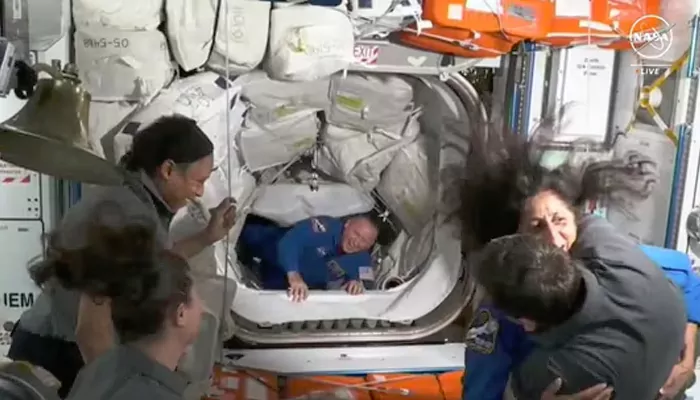
Here are today’s most important updates from the realm of Science and Space.
Pollen Allergies May Have Caused Extinction Of Woolly Mammoths - Study
Woolly mammoths (similar to modern-day elephants) extinct about 4,000 years ago - believed to be because of climate change and human activities. Now, according to a recent study, “pollen allergies may have played a major role in wiping out those ancient giants”. The study, published in Earth History and Biodiversity, claims that pollen-induced allergies after the last Ice Age could have caused allergic reactions, blocking mammoths’ sense of smell. This may have reduced their ability to find food, escape predators, and even locate mates, leading to their extinction.
Sebuah studi baru mengungkap bahwa ledakan vegetasi pada akhir zaman es terakhir mungkin berkontribusi pada punahnya mamut berbulu, dengan melepaskan begitu banyak serbuk sari hingga menyebabkan reaksi alergi yang mengganggu penciuman hewan-hewan tersebut. Para peneliti… pic.twitter.com/rZQLUvSvkW
— Mongabay Indonesia (@MongabayID) September 28, 2024
(Credit: Mongabay Indonesia)
NASA Set To Launch Rescue Mission For Stuck Boeing Astronauts
NASA astronauts Sunita Williams and her colleague Butch Wilmore (after flying on Boeing Co.’s Starliner spacecraft) have been stuck at the International Space Station (ISS) for quite some time now. According to the latest reports, NASA is all set to launch the SpaceX Crew-9 mission on September 28, at 1:17 PM EDT to bring home them. Notably, it has been delayed multiple times due to various technical issues and weather conditions.

The launch will take place from Cape Canaveral Space Force Station in Florida. It will feature NASA astronaut Nick Hague and Roscosmos cosmonaut Aleksandr Gorbunov and will have two empty seats next to them that the stuck Boeing astronauts will fill when the spacecraft returns in early 2025.
Astronomers Have Discovered What Earth Might Look Like In Eight Billion Years
The sun is expanding and is expected to swallow Mercury, Venus, and possibly Earth and Mars in about five billion years (before running out of fuel). But if that doesn't happen, and the Earth manages to survive, our planet might be about twice as big as its current size in about eight billion years.
Astronomers have discovered a rocky planet (located 4,000 light-years away from the Earth), known as KMT-2020-BLG-0414, which offers a perspective on Earth's potential future.
Exoplanet reveals the fate of Earth in 8 billion years from now: A rocky exoplanet located 4,000 light years away in the Milky Way provides a possible preview of Earth's fate billions of years from now. https://t.co/yuVzaTz04p #EarthDotCom #EarthSnap #Earth pic.twitter.com/4svBH0Q1Mw
— Earth.com (@EarthDotCom) September 27, 2024
(Credit: Earth.com)
Keming Zhang, an astronomer at the University of California, San Diego, wrote in his thesis, "In any case, Earth will only be habitable for another billion years, as the oceans will vaporize due to the runaway greenhouse effect long before the risk of being swallowed by the red giant arises.”
Comet C/2023 A3 Is Set To Pass By Earth, Appearing Brighter
The Comet C/2023 A3 from Oort Cloud (a vast cloud of icy planetesimals surrounding the Sun at distances ranging from 2,000 to 200,000 AU) has been traveling inwards into the solar system. Also known as Comet Tsuchinshan-ATLAS, it is all set to pass by Earth on its way towards the Sun, and hence is appearing remarkably bright.
This morning, I captured another image of Comet C/2023 A3 (Tsuchinshan-ATLAS) from the @LCOAstro site in the Atacama Desert, Chile 🇨🇱✨😱. The view was absolutely stunning !!! The comet is clearly visible visually. My gear: Nikon D810a camera with a 135mm lens. Exposure: 20 x 30… pic.twitter.com/lieSFHEP1W
— Yuri Beletsky (@YBeletsky) September 26, 2024
(Credit: Yuri Beletsky)
The comet appeared its brightest on September 27 from several parts of the Earth. It will continue to be visible till at least October 2. NASA has clicked some pictures of the icy celestial visitor from the International Space Station (ISS).
It is totally awesome to see a comet from orbit. The perspective of rising through the atmosphere on edge is truly unique from our vantage point. The comet tail is still too dim to see with your eyes, but it is heading towards the sun and growing brighter every day.
— Don Pettit (@astro_Pettit) September 22, 2024
This comet… pic.twitter.com/wsrevVpjDv
(Credit: Don Pettit)
Notably, it was discovered in 2023 and is currently traveling at a speed of 180,000 mph toward the Sun.
IIT Kanpur Has Unveiled New Facility In Detonation Research
The Aerospace Engineering Department at the Indian Institute of Technology Kanpur has recently demonstrated a new Detonation Tube Research Facility (DTRF), which may lead to enhanced research in combustion and propulsion. Developed by Prof. Ajay Vikram Singh, and funded by the Aeronautics Research and Development Board, DRDO, and ISRO, this facility is first-of-its-kind and has been accomplished in two years only. It's expected to prevent mining and industrial accidents, predict wildfire paths, increase the efficiency of high-speed detonation-based engines, and advance aerospace applications.
A moment of elation as IIT Kanpur unveils its Detonation Tube Research Facility, a first of its kind in India.
— IIT Kanpur (@IITKanpur) September 27, 2024
Funded by the Aeronautics Research and Development Board, DRDO; and the Indian Space Research Organization, and developed by Prof. Ajay Vikram Singh and his research… pic.twitter.com/luxt2DNlE1
(Credit: IIT Kanpur)



.webp)
.WEBP)
.WEBP)
.webp)
.webp)


.webp)
.webp)
.webp)